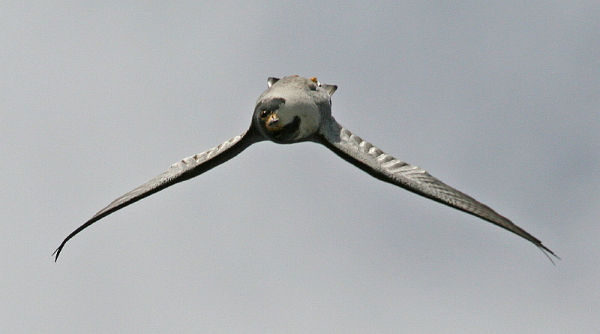
For the peregrine nestlings at Pitt, the coming week will be the most important time in their lives. They’re going to learn to fly.
If they’re successful, they’ll eventually be able to do this.
Yes, this picture is quite real. It isn’t Photoshop. This peregrine is flying upside down!
He’s their brother, Stammy, born at Pitt in 2003.
One day before they had ever flown, Stammy and his siblings were lined up on the nest rail, loafing. Their father (Erie) decided they needed a stimulus to get them excited about flying.
First Erie flew back and forth in front of the nest rail. He zoomed faster and made sharp turns. Eventually a few of his children flapped their wings in imitation. Not good enough.
Erie swooped down and zoomed up the face of the building from below. His offspring flapped enthusiastically. Then he made a wider circle, did a loop-the-loop and flew in upside down. His kids went nuts with excitement and so did I!
As the years went by, Erie aged and did fewer exciting flight demonstrations. This year E2 is a new father so maybe I’ll get a chance to see him teach some fancy flying.
I’m looking forward to the lessons.
Thanks to Chad & Chris Saladin for permission to use their photo of Stammy.
OUTSTANDING picture! How did he manage to get it?
I didn’t realize they (fledglings) had to be taught to fly. I assumed they would try several times from ledge to ledge before going airborne. Is it always the father who teaches them to fly? Who teaches them to hunt?
Photo: Not sure how Chad & Chris got this picture. They monitor the perergine sites in Ohio, have lots of experience with peregrines and have a very good camera. Since they both use the camera, they don’t label which one of them took the picture.
I will be featuring more of their excellent photos in the next week or two.
Taught to fly:
The young birds learn by a combination of experimentation and watching the example of their parents. I think it’s similar to how human babies will crawl before they walk. Adult humans rarely crawl; adult peregrines rarely walk. Babies start with something easier and work up to the harder stuff by watching what the adults do.
Who teaches:
Both parents teach. The father peregrine is the main “bread winner” so he teaches hunting when he brings food back to the fledglings. The fledglings will learn to hunt about a week after they fly.
Once they learn to fly, how far away from their nest box will they venture? Do they practice flying and gradually leave? Do they typically stay in the region or roam widely? Will the parents still use the nest box as a sort of home base, even though they won’t need it again until next Spring? Do they sleep there?
The chicks learn to fly gradually by running and flapping along the ledges. You can see them do this on the Aviary webcam. Today one of the chicks figured out how to fly-jump up to the camera ledge and back down to the nest.
After the chicks have flown out from the building for a day or two they will not return to the nest box. Their parents do not bring food to the nest after the last chick has fledged, so there is no reason for the young birds to visit it. To them, life is much more interesting on the wing than in the “baby crib” they just escaped from.
In late June the young birds will leave their parents’ territory in widening exploratory travels. After one of these short trips they may come back to Pitt for a day or two but they leave again soon. By late July they leave their parents’ territory forever. They spend a year or two wandering and then, in late winter, they look for a place to nest somewhere else far or near – but not at Pitt.
The adult peregrines do not use the nest again until the following spring. They do not sleep in it. The only thing I’ve noticed is that in late June / early July, Dorothy sometimes visits the nest briefly and looks at it as if to say “How quickly they grow up and leave home!”
what maneuver was the bird doing when they photographed it upside down?
Nathan, I don’t know the answer for this photo but when I’ve seen it in person the bird was flying a loop-the-loop like a stunt airplane.